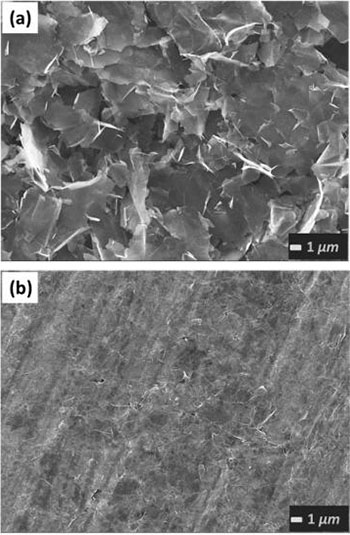
SEM images of the binder-free graphene ink immediately after drying step (top) and after subsequent compression (right). The team found that simple compression of the ink under a roller could boost its electrical conductivity 50-fold. [Image: Xianjun Huang et al./ University of Manchester]
A research team from the University of Manchester, U.K., has developed a process for printing binder-free graphene ink with high electrical conductivity and at low cost, and have used the process to print out a flexible radio frequency (RF) antenna (Appl. Phys. Lett., doi: 10.1063/1.4919935). The scientists believe that the technique could offer a cost-effective new avenue for putting the power of graphene components to work commercially in applications ranging from RFID tags to wearable electronics.
Conductive inks from graphene, the celebrated 2-D material first isolated in 2004, are nothing new, and were, in fact, one of the first commercial applications developed after the material’s initial description. These inks, which begin with dispersing graphene flakes into a host solvent, have generally had favorable cost and attractive physical characteristics such as flexibility. But many production processes, to help the ink stick to the substrate it’s applied to, have required the addition of binder materials into the ink solvent—a step that requires additional thermal annealing after application, at temperatures of 250 ºC, to ratchet up the conductivity to acceptable levels. That, in turn, makes the ink impractical for substrates (such as paper and plastic) in many potential applications in flexible and wearable electronics.
To get around those limitations, the Manchester team developed a process whereby a binder-free graphene ink is printed onto the target surface, allowed to dry at an ambient temperature of 100 ºC, and then compressed under a roller. The researchers found that the compression step conferred a dual benefit: it improved the adhesion of the graphene to the substrate, and it increased the conductivity of the applied graphene 50-fold. And, while not a room-temperature process, the new scheme requires temperatures much lower than those needed for binder-based inks.
As a proof of concept, the team used the technique to fashion a flat, half-wavelength dipole RF antenna on paper out of the graphene laminate. While clearly not a production model, the antenna, according to the researchers, provided “practically acceptable return loss, gain, bandwidth, and radiation patterns”—an indication, they say, of the new technique’s potentially broad applicability in flexible-electronic applications requiring RF communications, including wearable electronics and sensors.
